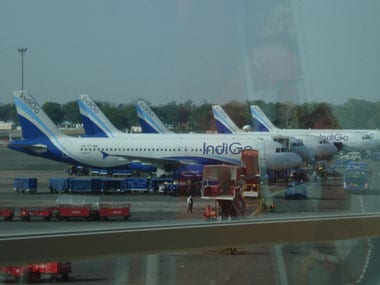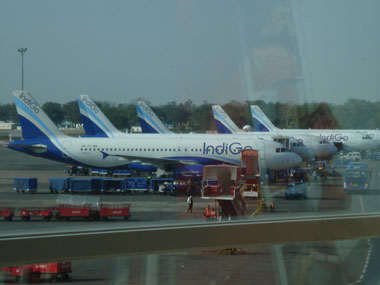New Delhi: What makes IndiGo the largest airline in India in terms of passengers carried, with a track record of consistent profitability too? Well, now that the notoriously reticent airline is planning to get listed on the Indian bourses, some details are emerging courtesy its Draft Red Herring Prospectus (DRHP). In the DRHP, IndiGo claims it has managed to remain the market leader and a profitable one at that due to a consistent strategy. The pillars of this strategy include consistent low fares, young and trouble free fleet, consistent on-time performance, no offers of lounges, frequent flyer miles or other full service airline trappings, using a single type of aircraft and making sure aircraft usage is at its maximum.[caption id=“attachment_2320886” align=“alignleft” width=“380”]  On IPO tarmac. Reuters[/caption] Lets give you some stats here from IndiGo’s DRHP: ** Indigo says it has a low number of employees per aircraft at 110 as on April this year. This helps with keeping overall costs low. Air India, in comparison, has had to hive off labour intensive functions like ground handling, engineering and MRO services to come close to this number. And SpiceJet had to reduce manpower significantly over the last few months while restructuring all aspects of the organisation to turn around. ** Daily aircraft utilisation is 11.4 hours as December last year. Again, a high aircraft utilisation helps contain costs and something most other airlines struggle with. ** Passenger revenue in FY14 was Rs 9,923.98 crore while revenue per passenger was Rs 4.29. Total revenue has grown by almost 44% year on year between 2010 and 2014. ** Ancillary revenue has been growing at healthy rates and accounted for 10.4% of revenue from operations in FY14. ** Operational reliability was 99.95% in FY15 which means relatively very little maintenance trouble with Indigo’s fleet. ** IndiGo has the lowest CASK (cost per available seat kilometer) excluding fuel cost of 2.87 cents among the Indian carriers. IndiGo’s CASK excluding fuel cost reduces further to 2.51 cents on the exclusion of maintenance reserves. In comparison, GoAir, SpiceJet, Jet Airways and Air India have CASK excluding fuel costs of 3 cents, 3.74 cents, 5.82 cents and 6.35 cents, respectively. Jet’s costs are roughly twice and Air India’s close to two-and-a-half times those of IndiGo. **As of December 2014, IndiGo had more passenger flights in India than any other airline, averaging 515 flights a day. IndiGo’s avowed strategy of low fares, young fleet, no frills services sounds quite simple. But it is not really so, or other LCCs in the Indian market would not have suffered even after legacy issues and fleet inconsistency. Except IndiGo, the only other airline which has shown any profits in recent years is GoAir. But look at its size: GoAir has a small fleet of only 19 aircraft as of now compared to IndiGo which operates 96 aircraft today. All other airlines in India are in the red, never mind which service model they follow and how big their fleet may be. According to details provided by IndiGo in the DRHP, this is the only airline which has turned in a profit consistently for six years in a row till FY2014. Aviation consultancy CAPA has already said that IndiGo turned in a handsome profit in FY15 so that makes it a seventh consecutive year of profitability for the airline. In the DRHP, IndiGo says it was the most profitable carrier in India for FY2014, as measured by EBITDAR margins, with a margin of 19.8 percent. Margins for GoAir during that period were 16.9 percent, Jet Airways just 5.9 percent, SpiceJet 2.3 percent and Air India -9 percent. So in FY14, when IndiGo was enjoying close to 20 percent margins, SpiceJet was languishing at a tenth of that number, Jet Airways was at less than a third and Air India was of course losing money. IndiGo’s aggression and what some call an overoptimistic assessment of the growth potential of Indian aviation market was apparent from day one. It began operations in 2006 but had already placed what was till then the single largest aircraft order in history with Airbus for 100 A 320 aircraft. In the DRHP it says that all deliveries under this order have been completed, two years ahead of schedule. Then, it went ahead and placed another jaw-dropping 180 aircraft order with Airbus in 2011, another record of course. Deliveries from this order will begin later this year but despite all the hype surrounding IndiGo’s fleet expansion, the airline will be left with only 111 aircraft as of 2016 (net of retirements). In the DRHP, the airline has also disclosed that the term sheet for its much-publicised third aircraft order, for 250 Airbus 320neos, has expired. Though IndiGo says it remains in active discussions with Airbus for potential acquisition of a “significant” number of aircraft from Airbus, two things will now be uncertain: will IndiGo manage to negotiate 250 or less number of Airbus 320neos for future growth and what will be the terms under which these aircraft will be acquired. Remember, IndiGo follows the well-known airline industry practice of sale and lease back of aircraft with significant cost advantages to itself and part of the reason it has seen unprecedented financial success in the Indian market is due to its ability to negotiate beneficial contracts from Airbus - because of its bulk orders earlier.
IndiGo’s aggression and what some call an overoptimistic assessment of the growth potential of Indian aviation market was apparent from day one.
Advertisement
End of Article


)

)
)
)
)
)
)
)
)



